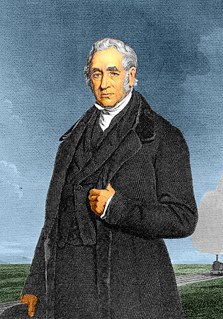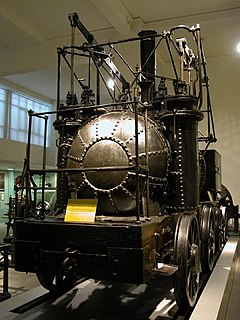
George Stephenson was a British civil engineer and mechanical engineer. Renowned as the "Father of Railways", Stephenson was considered by the Victorians a great example of diligent application and thirst for improvement. Self-help advocate Samuel Smiles particularly praised his achievements. His chosen rail gauge, sometimes called 'Stephenson gauge', was the basis for the 4 feet 8+1⁄2 inches (1.435 m) standard gauge used by most of the world's railways.

Robert Stephenson FRS HFRSE FRSA DCL was an English civil engineer and designer of locomotives. The only son of George Stephenson, the "Father of Railways", he built on the achievements of his father. Robert has been called the greatest engineer of the 19th century.

Killingworth, formerly Killingworth Township, is a town north of Newcastle Upon Tyne, in North Tyneside, England.

Puffing Billy is the world's oldest surviving steam locomotive, constructed in 1813–1814 by colliery viewer William Hedley, enginewright Jonathan Forster and blacksmith Timothy Hackworth for Christopher Blackett, the owner of Wylam Colliery near Newcastle upon Tyne, in the United Kingdom. It was employed to haul coal chaldron wagons from the mine at Wylam to the docks at Lemington in Northumberland.

The Bowes Railway, built by George Stephenson in 1826, is the world's only operational preserved standard gauge cable railway system. It was built to transport coal from pits in Durham to boats on the River Tyne. The site is a Scheduled Ancient Monument. The railway is open every week on Thursday, Friday and Saturday as well as on a number of event days throughout the year.

The North Tyneside Steam Railway and Stephenson Steam Railway are visitor attractions in North Tyneside, North East England. The museum and railway workshops share a building on Middle Engine Lane adjacent to the Silverlink Retail Park. The railway is a standard gauge line, running south for 2 miles (3.2 km) from the museum to Percy Main. The railway is operated by the North Tyneside Steam Railway Association (NTSRA). The museum is managed by Tyne and Wear Archives and Museums on behalf of North Tyneside Council.

Wylam is a village and civil parish in the county of Northumberland. It is located about 10 miles (16 km) west of Newcastle upon Tyne.

Newburn is a semi rural parish, former electoral ward and former urban district in western Newcastle upon Tyne, North East England. Situated on the North bank of the River Tyne, it is built rising up the valley from the river. It is situated approximately 5 miles (8.0 km) from the city centre, 14 miles (23 km) east of Hexham and 13 miles (21 km) south south west of Morpeth. In the 2001 census, the population was given as 9,301, increasing to 9,536 at the 2011 Census. Newburn is in the Newcastle upon Tyne district of Tyne and Wear and is part of the parliamentary constituency of Newcastle upon Tyne North.

The Hetton colliery railway was an 8-mile (13 km) long private railway opened in 1822 by the Hetton Coal Company at Hetton Lyons, County Durham, England. The Hetton was the first railway to be designed from the start to be operated without animal power, as well as being the first entirely new line to be developed by the pioneering railway engineer George Stephenson.

Shiremoor is a large village in the Metropolitan Borough of North Tyneside. It is located approximately 3.5 miles (5.6 km) inland of Whitley Bay and approximately 3 miles (4.8 km) north of The Tyne Tunnel. A mile or so north of Shiremoor, the extensive built-up areas of North Tyneside change abruptly into green belt stretching north into south east Northumberland. It has a population of 4,782.

Salamanca was the first commercially successful steam locomotive, built in 1812 by Matthew Murray of Holbeck, for the edge railed Middleton Railway between Middleton and Leeds, England and it predated Stephenson's Rocket by 17 years. It was the first to have two cylinders. It was named after the Duke of Wellington's victory at the battle of Salamanca which was fought that same year.

Forest Hall is an area in the borough of North Tyneside in the United Kingdom. Named after a long gone palatial residence, it is a north eastern suburb of Newcastle and lies six kilometres from the city centre. Until the 1960s it was a sleepy village with a railway station on the main line from London to Edinburgh. While relatively affluent compared to some surrounding areas, its proximity to Killingworth has led to an increase in antisocial behaviour in recent years. For local government, most of the area is in Benton ward, while some residential streets towards the north and the east are in Killingworth ward. In the 1890s the area was home to the Clousden Hill Free Communist and Co-operative Colony.
George Stephenson High School is a large secondary school in Killingworth, North Tyneside. This is located in Newcastle Upon Tyne.

Steam Elephant was an early steam locomotive from North East England.

George Stephenson built a number of experimental steam locomotives to work in the Killingworth Colliery between 1814 and 1826.

Nicholas Wood FGS FRS was an English colliery and steam locomotive engineer. He helped engineer and design many steps forward in both engineering and mining safety, and helped bring about the North of England Institute of Mining and Mechanical Engineers, holding the position of President from its inauguration to his death.

The Hetton Colliery Lyon or Lyons is an early British steam locomotive that still survives in preservation. It is remarkable for having continued working into the early 20th century.

Steam springs or steam suspension are a form of suspension used for some early steam locomotives designed and built by George Stephenson. They were only briefly used and may have been used for fewer than ten locomotives.


















